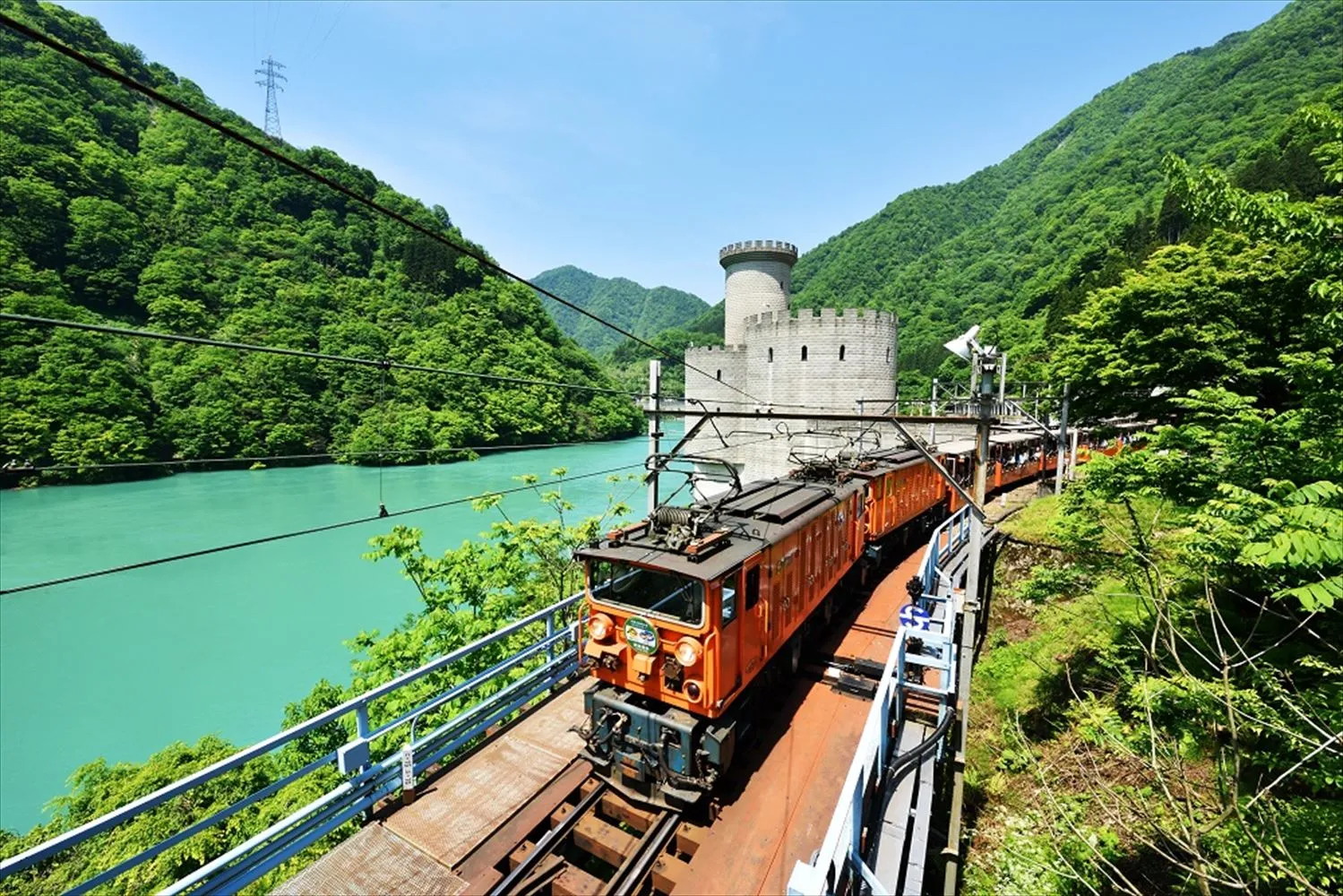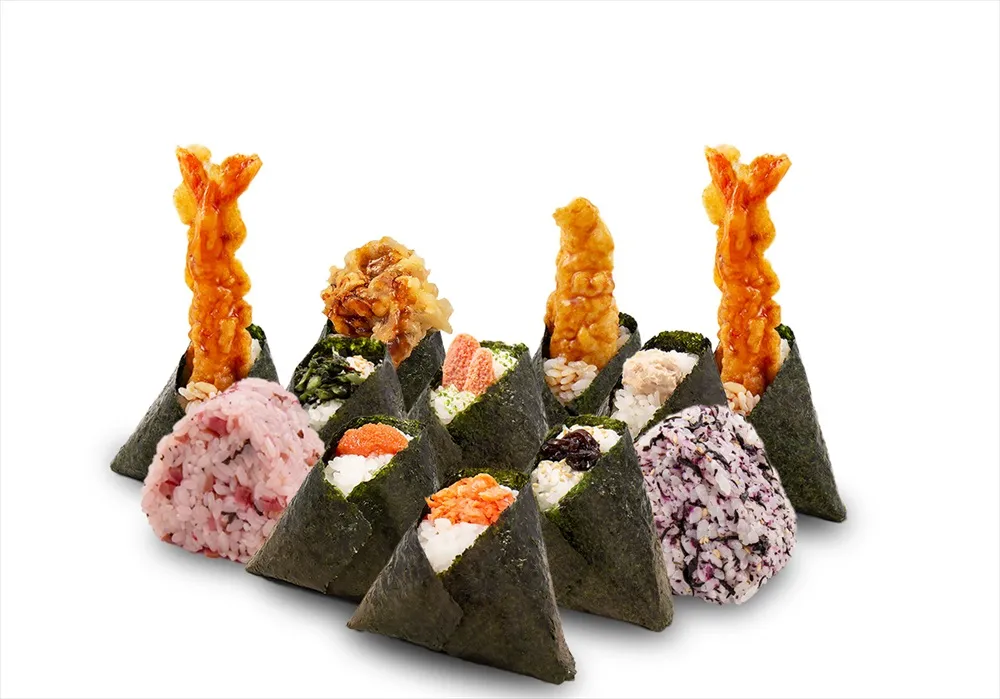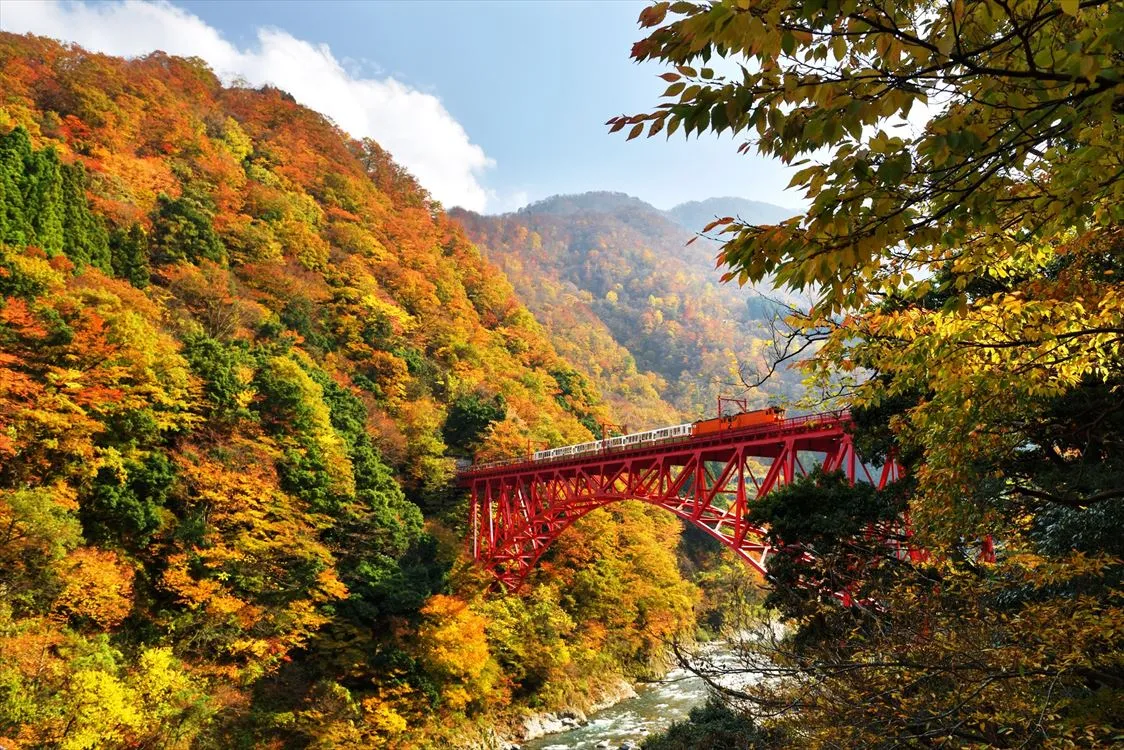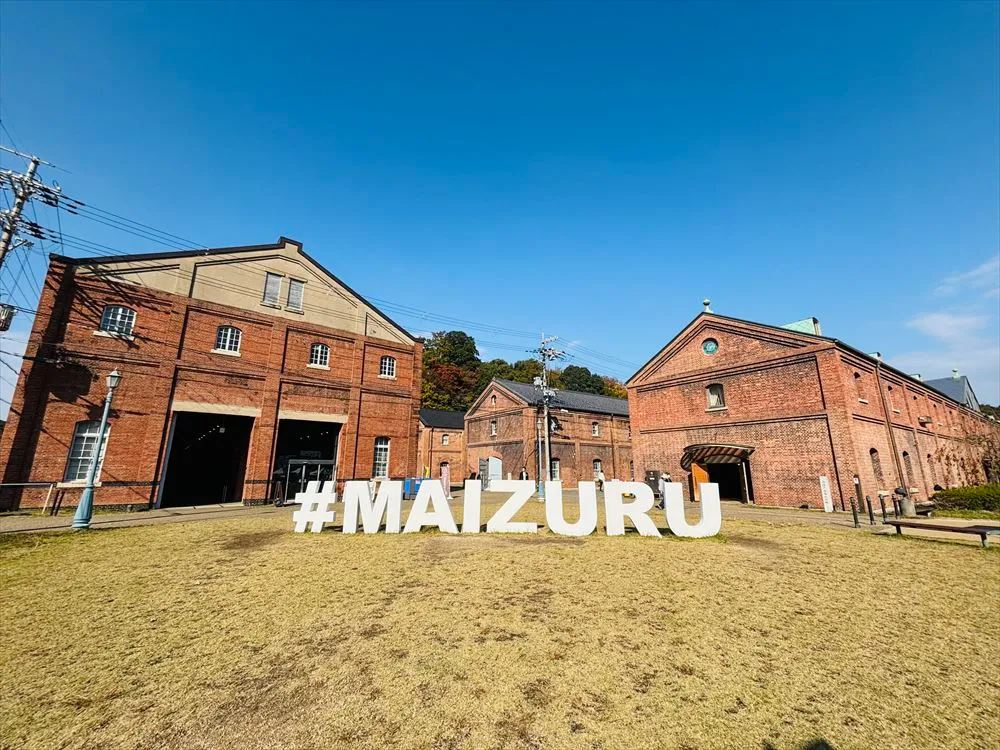TOYAMA / KUROBE / TATEYAMA
TOYAMA / KUROBE / TATEYAMA

Toyama Prefecture is surrounded on three sides by mountains and has more than 300 rivers and streams originating in these mountains. Here you will discover the magnificent Tateyama Mountain Range, Japan’s most torrential river, the Kurobe River, and delicious food. Toyama’s true charms are still not well known outside the region.
In this article, att.JAPAN features the central and eastern parts of Toyama Prefecture, which may put the reader in mind of the rustic charms of travel in older days of Japan.?
<Toyama>
Toyama
A journey of Toyama, Kurobe and Tateyama starts at Toyama Station. Streetcars run in the city starting from Toyama Station. As they run every 5-10 minutes and the routes are easy to understand, they are quite useful. By streetcar you can go to the Iwase area, where traditional houses have been reconstructed. Toyama Light Rail, Japan’s first full-scale LRT (Light Rail Transit) began operating in 2006. Since then the system has received nationwide attention, especially among railway fans.
Toyama was ruled by strong neighboring clans or prefectures for a long time and also has long suffered from natural disasters. The Jinzu and the Joganji rivers often caused floods and strong southerly winds have frequently caused major fires. Toyama is no stranger to big earthquakes, cold weather in summer and heavy snow in winter. It was not wealthy, but the Toyama clan developed industries in the Edo period (1603-1867) suited to the environment of this region, overcoming adversities.
Medicine manufacturing is the most famous industry of Toyama. Medicine peddling was promoted by the feudal lords and peddlers traveled throughout the country for 300 years. This energized exchanges with other domains and made the Toyama clan an enterprising one. Their business was based on a policy of “use now pay later.” Peddlers left medicines with each family, and collected money only for medicines that the family actually used when they visited next time. This was a very innovative business method for those days and especially welcomed by villagers who lacked cash income. The pharmaceutical industry is still Toyama’s major industry, and boasts advanced technologies. Kokando is a venerable pharmaceutical company established in 1876. Its museum exhibits drug-making tools of older days, old willow basket trunks of peddlers, current manufacturing processes and a history of Toyama’s pharmaceutical industry.
Drug-selling companies accumulated vast amount of money through their unique business method and capabilities. They invested in financial institutions, hydropower, railway and manufacturing industries, and build a foundation of modern industry during the Meiji period (1868-1912). Toyama’s first hydraulic power plant built in 1899 enabled the supply of abundant and cheap electric power. As a result, more and more modern factories were built. There are many museums in the town. Although most buildings in the town were burned down by air attacks during WWII, the town was dramatically reconstructed after the war and numerous cultural facilities and museums were built in the tidy town. The prefectural Toyama Suiboku Museum was the first ink painting museum established in Japan. Its Japanese garden is attractive.?
<Kurobe/Unazuki>
Unazuki Onsen/Kurobe Gorge
Kurobe Gorge is surrounded by precipices. The securest way to visit there is using the tram, which was originally laid down to develop a power plant. Now a tram for sightseeing runs 20.1 km from Unazuki Onsen to Keyakidaira in 80 minutes at a slow speed. It runs through 41 tunnels and over 22 bridges, with a wide variety of scenery (outside the tunnels!). The gorge creates scenes of stunning beauty, regardless of the season. Atohiki Bridge is 60 meters high above the river; this is a place that used to scare foot travelers because of its precipitous height. You can enjoy famous places for autumn leaves and open-air hot spring baths along the riverbank. Sarutobi Gorge is a 20-minute walk from Keyakidaira Station. It is a very narrow gorge and the name “Sarutobi” indicates that a monkey can jump from one side to other side. The tram operation is from mid-April to November, but the exact date depends on snow depth. Please note that this area does not connect to Tateyama Kurobe Alpine Route.
Uozu/Namerikawa
Take a train on the Hokuriku Line from Toyama Station to Uozu Station. Interestingly, from early spring to summer each year, the local weather forecast, in addition to the probability of rain, also indicates the probability of a mirage for the next day. Mirages, for example, scenery on the “opposite shore” or strange-looking ships, are sometimes seen on the sea off Uozu. The reason why such mirages occur is still now not fully understood, but it is said that the mirage probability is high on clear days when the temperature is predicted to rise during the day. In spring, Toyama Bay is famous for firefly squid. They usually dwell in the depths of the sea, but come to shallower water near the coast to spawn in spring. Small firefly squid, so-called for their luminescent body surface, emit blue and white light and the sight created by a large shoal resembles The Milky Way. You can see firefly squid-fishing from sightseeing boats, which set off from Namerikawa Fishing Harbor. Mysterious lights fantastically shimmer in the sea before dawn.
Tateyama Kurobe Alpine Route
Mountains of around 3,000 meters are strung together to comprise the Tateyama Mountain Range, such as 3,015-meter Mount Onanji, 3,003-meter Mount Oyama, and 2,880-meter Mount Betsuzan. Tateyama is one of the three sacred mountains of Japan along with Mount Fuji, Yamanashi and Shizuoka prefectures, and Mount Hakusan, Ishikawa Prefecture. The harsh terrain generally prevented people from reaching this area, excluding shugendo mountain ascetics and mountain climbers, until recently. In 1971, Tateyama Kurobe Alpine Route was opened and it enabled ordinary tourists to tour Tateyama. Tateyama Kurobe Alpine Route goes through the Northern Japan Alps Mountain Range from Toyama to Nagano prefectures, with cable cars, buses, ropeway, and trolleybuses.
Go to Bijodaira from Tateyama Station on the Toyama Chiho Tetsudo railway. Bijodaira is a 1,000-meters-above-sea-level plateau and has some 140 giant Japanese cedars called Tateyama-sugi which are more than six meters around. You can enjoy basking in the woods or bird watching on beautiful walking trails. Transfer to the Kogen (plateau) Bus to Murodo at 2,450 meters, and enjoy seeing Shomyo Fall, one of the largest waterfalls in Japan with a 350 meter fall, and Midagahara on the way. Hannoki Fall can be seen near Shomyo Fall in the thawing season, usually from April to July. Midagahara, a high moor at altitude 2,000 meters, is blessed with abundant alpine flora. There are walking trails in the moor. The bus cannot go to Murodo during winter due to snow cover. In mid April the road is opened to traffic. As snow removal operations proceed, 20-meter high snow walls are created on both sides of the road. Until the end of May, the majestic snow corridors called “Yuki no Otani” attract many people.
As the bus approaches Murodo, your horizons widen and the overwhelming beauty of Tateyama Mountain Range comes into view. There are walking trails around Murodo. Mikuriga-ike Pond has mysterious blue water. Mikuriga-ike Onsen is a hot spring which is located at the highest elevation of any hot spring in Japan. Rocks yellowed by sulfur and white fumarolic gas are seen in stark Jigokudani Valley. About 330 snow grouses, which are national natural treasures, live around Tateyama and especially many of them live around Murodo. Thus chances of seeing them are high. Their protective color is very different depending on seasons; in summer brown and in winter white. If you climb two hours from Murodo bus terminal, you can reach the Mine main shrine of Ozan Shrine on the top of Mount Oyama.

Tateyama trolleybus connects Murodo to Daikanbo, and runs 2,300 meters above sea level, the highest place for a bus running anywhere in the world. Daikanbo commands splendid panoramic views of the mountains. Transfer to Tateyama Ropeway and go to Kurobe-ko Station. You can also have a fine view from the ropeway. It takes 15 minutes from Kurobe-ko Station to Kurobe Dam Station by foot on the dam. Enjoying seeing Lake Kurobe and Kurobe Dam as you go. Kurobe Dam is the largest arched-dome type dam in Japan. Panoramic views of the mountains are spectacular. A trolleybus brings you from Kurobe Dam Station to Ogisawa Station, Nagano Prefecture. Change to a local bus and go to Shinano Omachi. Omachi Onsen on the way, surrounded by white birches and Buna beeches, is a hot spring resort built in 1964. Riding various types of vehicles is enjoyable enough, but walking and enjoying the sights all along the Tateyama Kurobe Alpine Route at your own pace in a leisurely manner is highly recommended.
Festival in Yatsuo
Yatsuo, a hilly town, is well known for Owara Kaze no Bon festival. The town prospered as a commercial town that traded silk yarn and Japanese paper during the Edo period. Townspeople sing and dance for three days and nights from September 1st to 3rd every year. The town is filled with an air of excitement during that period of time, which is entirely different from the usual quiet town. Lanterns along several streets are lit after dark and create a fantastic ambience. To the accompaniment of the sounds of shamisen (a three-stringed musical instrument), drums and kokyu (Chinese fiddle), plaintive Owara folk songs are heard. Townspeople wearing the same happi coats or yukata and hats, which are made of woven straw, dance around the town.
Food
Various kinds of seafood are caught in Toyama Bay throughout the year because of the peculiar? topography of its seabed and complicated ocean currents. Kanburi, or a yellowtail caught in winter, is very delicious as its flesh is condensed by the rough seas of winter. Buri-shabu in which thinly-sliced pieces of a yellowtail are lightly dipped in hot soup stock and then eaten is a popular dish of recent date. Sashimi of shiroebi (white shrimp) has a sophisticated sweetness and melts in the mouth. Firefly squid have a rich flavor. Benizuwai-gani (snow crab) and kamaboko (steamed fish pastes) are also famous and sushi pressed in a mold on which pieces of a trout are put is a popular Eki-ben (railway boxed meal). Sake produced from clear water from the Northern Japan Alps is also very tasty.?
| Access | Access to Toyama :【By air】 60 minutes from Tokyo to Toyama Airport 【By rail】: 3 hours 10 minutes from Tokyo to Echigo-yuzawa by JR Joetsu bullet train and from Echigo-yuzawa to Toyama by limited train Hakutaka on the Hokuriku Line. |










